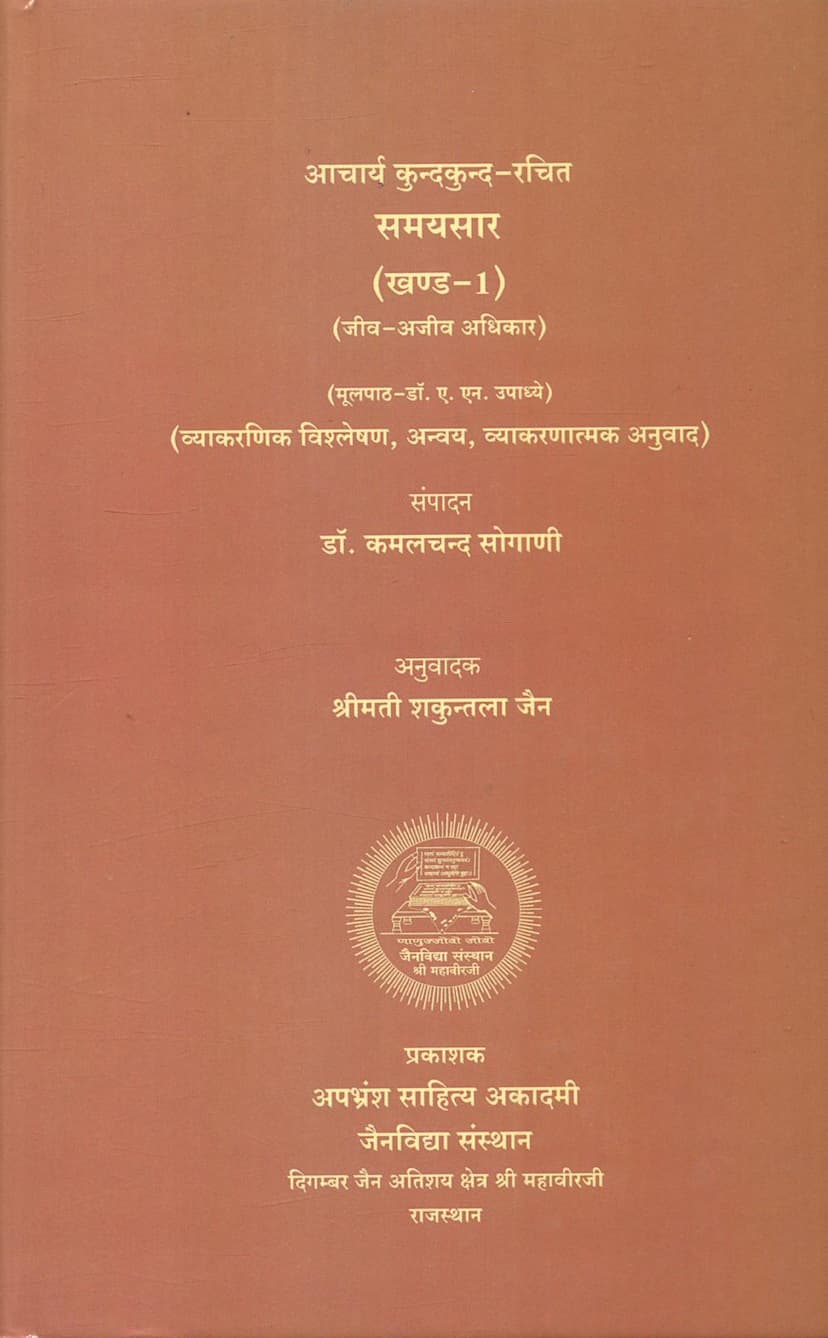Samaysara Part 01
Added to library: September 2, 2025

Summary
Here's a comprehensive summary of "Samaysara Part 01" based on the provided text:
Book Title: Samaysara Part 01 (समयसार खण्ड-1) Author: Acharya Kundakunda (आचार्य कुन्दकुन्द-रचित) Editor: Dr. Kamalchand Sogani (संपादन डॉ. कमलचन्द सोगाणी) Translator: Mrs. Shakuntala Jain (अनुवादक श्रीमती शकुन्तला जैन) Publisher: Apbhramsa Sahitya Academy (अपभ्रंश साहित्य अकादमी) Content Focus: Jiva-Ajiva Adhikara (जीव-अजीव अधिकार) - Verses 1 to 68 of Samaysara.
Overall Purpose and Significance:
"Samaysara" is considered a seminal work in Jain philosophy, presented in the Shauraseni Prakrit language. This first volume (Jiva-Ajiva Adhikara) lays the foundation for understanding the core Jain concepts of the self (Jiva) and non-self (Ajiva). The book aims to guide readers towards spiritual perfection and self-realization by elucidating the nature of the soul and its relationship with the material world.
Key Concepts and Themes Presented in Part 1:
-
Swasamaya (स्वसमय) and Parasamaya (परसमय):
- Swasamaya: This refers to the soul's true nature, its inherent state of being identified with its own qualities (knowledge, perception, conduct). It is the state of "oneness" (ए Dieses) achieved through self-realization.
- Parasamaya: This is the state of being identified with external things or conditions, such as material possessions, the body, or external experiences, leading to attachment and suffering. The book emphasizes that attachment to "paras" (other) leads to a state of conflict and unhappiness.
-
Nischaya-vyavahara (निश्चय-व्यवहार) Methodology:
- Acharya Kundakunda introduces a crucial dual perspective to explain complex spiritual truths.
- Vyavahara (व्यवहार): This is the conventional, worldly, or external perspective. It's like an "outward view" or "societal view" that uses worldly language and analogies to convey spiritual concepts. For example, it might describe the soul as having knowledge, perception, and conduct.
- Nischaya (निश्चय): This is the ultimate, absolute, or internal perspective. It's the "inward view" or "soul-view" that describes the soul in its pure, unadulterated state. In this view, the soul is purely a knower (ज्ञायक) and is distinct from its attributes like knowledge, perception, and conduct, as these are seen as its manifestations, not its essence in isolation.
- The text uses numerous examples to illustrate this distinction, such as:
- Vyavahara sees a wise person as having knowledge, perception, and conduct; Nischaya sees the soul as purely a knower, beyond these specific attributes.
- Vyavahara may equate the soul with the body, while Nischaya firmly separates them.
- Vyavahara might consider praising the physical body of an enlightened being, but Nischaya asserts that true praise lies in recognizing the soul's inherent qualities, not the body's attributes.
-
The Nature of the Soul (Jiva - जीव):
- The soul is described as pure consciousness (चेतनागुण), without color, smell, taste, touch, sound, or any physical attributes. It is formless, eternal, and distinct from all non-soul substances (Ajiva - अजीव).
- The soul is devoid of attachment (राग), aversion (द्वेष), and delusion (मोह). It is also free from concepts like karma, inflow of karmas (asrava), bondage (bandha), cessation (samvara), and liberation (nirjara) in its pure state.
- The book systematically refutes the idea that the soul is identical to various categories like senses, karma, bodily forms, or even its own spiritual states (like different stages of spiritual progress, which are more conventional designations).
-
The Nature of Non-Soul (Ajiva - अजीव):
- Ajiva encompasses all substances other than the soul, primarily Pudgala (matter), which has color, smell, taste, touch, and form.
- The text clarifies that qualities like color, smell, taste, and touch are attributes of matter (Pudgala) and not of the soul, even though they may appear to be associated with the soul through karmic influence.
-
The Distinction Between the Knower and the Known:
- The book emphasizes that the soul, in its true nature, is a pure knower. While the soul perceives various objects, it is not affected or changed by them. This is highlighted through the distinction between "knowing" and "being."
-
The Path to Self-Realization:
- Achieving oneness (ए Dieses) with the soul requires abandoning attachment to external (anatma-drishti) and embracing the vision of the soul itself (atma-sthit-drishti).
- The path involves distinguishing between what is the soul and what is not, recognizing that all perceptions of karma, body, and their modifications are ultimately external.
- The ultimate goal is to realize the soul as pure knowledge and perception, devoid of all imperfections and attachments.
Methodology and Presentation:
- The book provides the original Prakrit verses (Gathas).
- Each verse is accompanied by a detailed grammatical analysis, including:
- Anvay (अन्वय): The grammatical reconstruction of the verse for better understanding.
- Vyakarana-atmak Anuvad (व्याकरणात्मक अनुवाद): A word-by-word and phrase-by-phrase translation with grammatical explanations.
- Sanketa-Suchi (संकेत-सूची): A list of abbreviations and symbols used in the grammatical analysis.
- Vyakhyan (व्याख्यान): Explanations and elaborations on the verses, often by the editor.
- Appendices are included with useful glossaries of nouns, verbs, adjectives, pronouns, and indeclinables, as well as information on Prakrit prosody and relevant literature.
In essence, "Samaysara Part 01" serves as an essential guide for understanding the fundamental Jain ontological principles of soul and non-soul, using a clear, analytical, and dual-perspective approach to lead the reader towards the realization of the soul's pure and inherent nature.